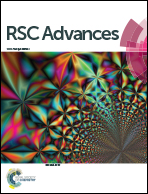Effects of organosolv fractionation time on thermal and chemical properties of lignins†
Abstract
Organosolv fractionation is a promising pathway to separate cellulosic biomass into high purity cellulose, hemicelluloses, and lignin. This work specifically investigates the properties of lignins isolated at specific time points as fractionation progressed, with the intent of correlating fractionation time with lignin purity, yield, thermal and chemical properties. Yellow poplar (Liriodendron tulipifera) was fractionated using a mixture of methyl isobutyl ketone, ethanol, and water with sulfuric acid as catalyst at 140 °C over a two-hour period. Aliquots of the liquor were collected by sampling every 15 min during the fractionation to generate a series of lignins. The results showed that with increased fractionation time, lignin purity improved from 90.3 to 94.6% and the glass transition temperature increased from 117 to 137 °C. The loss of aliphatic OH and increase of phenolic OH with fractionation time led to an increase in condensed structures and increased polydispersity at times greater than 90 min. Principal component analysis of Fourier transform infrared spectroscopic data confirmed the shift to higher purity and more condensed chemical structures with increasing fractionation time. Overall, this study demonstrates that thermal and chemical properties of lignin change with the organosolv fractionation time.


 Please wait while we load your content...
Please wait while we load your content...